
JÄGER Business Blog


WHITEPAPER
Find out which factors influence your SOP!
Price-focused purchasing strategies are a double-edged sword. On the one hand, it is important to minimize procurement costs to keep the organization as profitable as possible. On the other hand, price is rarely the only relevant factor. Companies that want to procure rubber and plastic components as cheaply as possible, for example, always accept cutbacks elsewhere, whether consciously or unconsciously.
Whether the lower purchase price is worth it in view of these trade-offs depends on the context. The challenge is to decide when purchasing should and should not work with low-cost suppliers.
A basic principle of business economics is that the price of a product must exceed its unit costs in the long term for it to be profitable. If a supplier offers goods at a lower price than the competition, this means that its costs are also correspondingly lower. As a result, customers have to make concessions elsewhere, be it in terms of quality or scope of services.
In the rubber and plastics industry, quality refers to material properties. A lower-quality material, for example, has a shorter service life, exhibits optical defects or has less chemical resistance than high-price materials. In some cases, this is the result of lower quality standards, for example with suppliers from certain low-wage countries. As a rule, however, the difference in quality is deliberate. In this way, the supplier serves a demand for materials in areas of application where premium products have negligible added value.
In addition, customers in the low-price sector have to make sacrifices in terms of performance. Rubber and plastic components from low-cost suppliers are generally standardized and can only be customized to a limited extent. In addition, these suppliers do not offer their customers any consulting services. They do not assist with material selection or provide input for product development. Often, they only have a limited portfolio that can be ordered “as shown.”
There are also limitations in terms of delivery conditions. Where other suppliers accommodate their customers, low-cost suppliers are relatively inflexible. They often supply goods only in the form of individual orders. They offer neither demand-oriented partial deliveries nor framework contracts or just-in-time concepts.

Consultation on the design of technical components
Low-cost rubber and plastic suppliers may have their weaknesses, but they still occupy an important niche. Situationally, it makes perfect sense to use lower quality materials.
For example, disposables that serve only as transport protection do not have to meet high standards. Their task is to prevent damage to the transported goods. Durability or chemical resistance are of secondary importance in such a case. Even non-visible components can make sacrifices, especially in terms of haptics and appearance.
The same applies to the scope of services. Not every company wants consulting services from a rubber or plastics supplier. Some customers are able to assess exactly what they want and are only looking for a favorable price. This is especially true when it comes to trivial applications with no special requirements for the material.
There are also different cases when it comes to delivery conditions. Some companies have no need for individual delivery concepts. Often, individual orders delivered in one batch are quite sufficient, for example for one-off projects.
For most companies, however, these are individual cases. As a rule, quality and scope of services play an important role and put a higher purchase price into perspective.
Especially in the rubber and plastics sector, there are often specific requirements for materials, depending on the area of application. Companies are almost always looking for a material that has certain chemical or physical resistances, can withstand certain temperature ranges or has special certifications. Having a supply partner on hand who also offers customized materials and provides his know-how for the selection is worth its weight in gold in these cases.
The same applies to transport conditions. If a component is earmarked for volume production, most customers want needs-based delivery agreements and production-oriented picking – both services that are lacking in the low-price segment.
In principle, there is nothing to be said against sourcing rubber and plastic components from low-cost suppliers. However, some companies do this for the wrong reasons. They act purely price-driven, ignoring factors that may argue against this type of procurement.
Frequently companies opt for rubber or plastic products that do not meet their requirements 100 percent because of the low price. For example, we had a customer who needed protective mats for his workshop. Despite advice, he opted for the cheapest option, which, however, had strong odors. After numerous complaints from the employees about the strong odor, the customer had to revise his decision and replace the protective mats.
Internal conflicts of interest are often to blame for such cases. The purchasing department is given the task of keeping costs as low as possible, while the design department wants to optimize the quality of the components. In some cases, the compliance department also requests as many certifications as possible to be on the safe side, which makes the situation even more complicated.
Since these conflicts cannot be easily resolved, the financial arguments usually tip the scales in the end. Whereby, for the sake of fairness, it should be mentioned that it also works the other way around: sometimes, for example, the design department wants oversized high-price materials that unnecessarily increase the cost of the product.
Rubber and plastics suppliers are also not entirely innocent in this situation. Their offers are often difficult to compare because they are not transparent enough. Customers sometimes compare pure purchase prices with prices that already include packaging and transport. However, their purchasing department overlooks the fact that another supplier might be a more favorable alternative when it comes to negotiating specific delivery concepts and picking. Some low-cost suppliers do not show all costs transparently, but only calculate individual items retrospectively. This makes comparison with the competition much more difficult.
Strong price focus is a widespread purchasing strategy, but it can cause problems. Companies that want to buy rubber and plastics as cheaply as possible simplify a complex decision-making process and therefore often end up with solutions that need improvement. Low-cost suppliers have their reason to exist, but they are not ideal in all situations, because a low price always requires sacrifices elsewhere.
The best way out of this situation is transparency. Companies should define their requirements as precisely as possible and include all costs when selecting suppliers in order to achieve the highest possible level of comparability. This creates an optimal information basis for selecting the right supplier.

Whitepaper: Secure the Start of Production
Learn which factors influence your SOP!

Share this post!
Jäger Gummi und Kunststoff GmbH
Lohweg 1
30559 Hannover
Tel. +49 511 – 53580
Fax +49 511 – 553394
info@jaeger-gk.de
Management:
Dr.-Ing. Andreas Jäger und
Julius Jäger
Hanover Register Court HRB 59798
DE 813 314 161